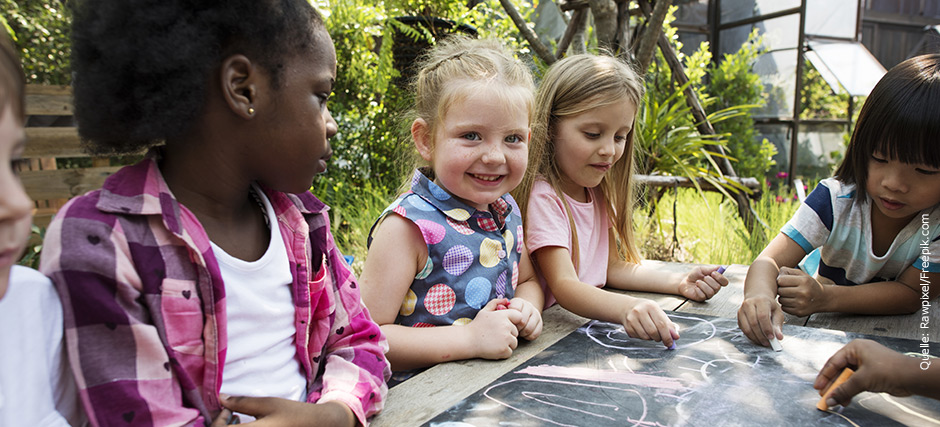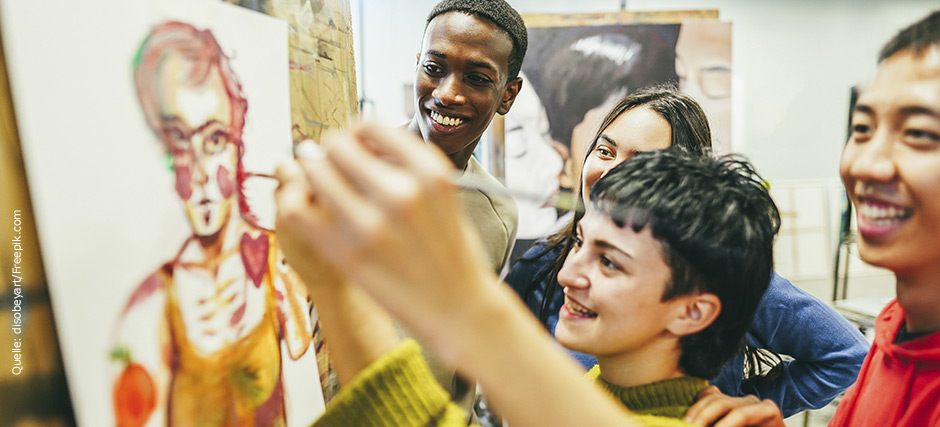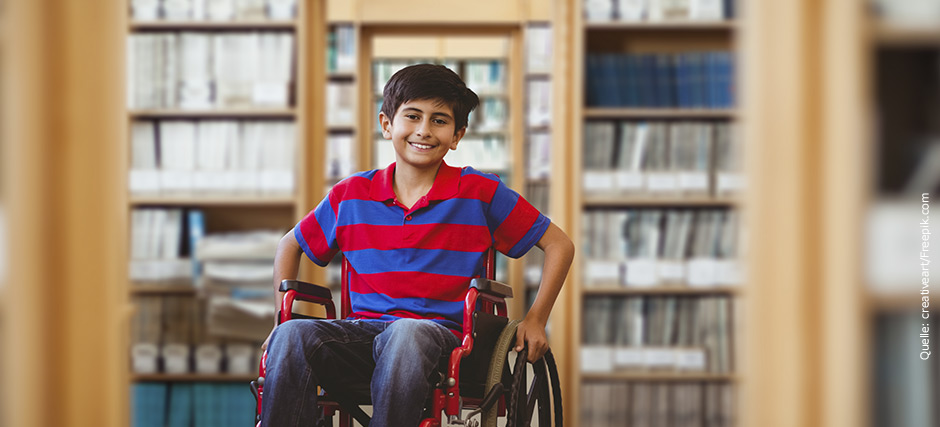LEBEN LERNEN -LEARNING TO LIVE
A discussion paper on child and youth policy presented by the Child and Youth Welfare Association (AGJ) at the 12th German Youth Welfare Day 2004
Discussion paper PDF
LEBEN LERNEN – LEARNING TO LIVE defines the task of our society to foster and support children “growing up under public responsibility”. But LEARNING TO LIVE implies more than merely institutional support and encouragement. Increasingly, children and young people see themselves facing both more chances and more risks in the process of organising their lives. In engaging responsibly and wilfully in this process, the majority of them evolve independent organisational forms. The slogan LEARNING TO LIVE highlights this trend towards independence and simultaneously emphasises the fact that both girls and boys, and young women and young men, would like to, and need to, engage in determining socialisation processes themselves. In this development, the desire to actively shape the organisation of one’s own life, from childhood to youth, has steadily increased and appears in a variety of guises.
The 12th German Youth Welfare Day focused on four main themes to highlight the situation of children and young people today, assess the provisions made for child and youth welfare and evaluate the facilities provided. These four main themes were considered under the headings: “The culture and cultures of growing up”; “Education as a life task”; “Being young in an aging society”; and “Social equitability is not a luxury”. Tackling these concerns does not only point to the societal challenges involved, but also raises questions relating to policy issues on children and young people and reveals the ambiguities in them.
- Families are the source of social, cultural and economic capital, but they also have their influence curtailed by institutions, medias, peer groups and many other factors, i.e., for children and young people, families have come to be more and less important in equal measure.
- Gender continues to be an influential factor, even though there has been a major alignment, in part, in girls’ and boys’ life situations and their ability to determine their own lives.
- In the context of the unification processes underway in Europe at present, the diversity of cultures living side by side has raised additional issues and made a variety of orientation tasks apparent.
- While education has become a life task and lifetime learning is now essential, educational qualifications no longer automatically guarantee security for an individual.
- Demographic developments are creating a situation where children are a scarce resource and yet, simultaneously, a marginal group within an aging society.
- While, on the one hand, increasing numbers of young people and families take participation in child and youth welfare provision for granted, current policies also harbour the risk of this being reduced to a service for disadvantaged persons only.
- Reforms to the social state are necessary, but these must be set against the benchmark of how far they adhere to the goal of social equitability for children, young people and their families.
The culture and cultures of growing up
New routes have been sought and found for the path through childhood and youth. This process has been accompanied by a structural increase in social risks and the problems needing to be solved by the individual, but coping adequately with these can no longer be organised exclusively from within the family. For example, in many cases families today cannot exclusively provide care for children prior to their entry into child day care facilities or for those time-blocks bridging school and family. The search for identity among children, young people and adults – especially in those coming from a migration background – and the need for orientation on issues around bringing up children all require socially integrative solutions.
Children and young people no longer universally perceive or accept socialisation authorities and institutions as significant or infallible. Today, children and young people are looking for and finding their own way, balancing school and peer group, family and outside activities, and individually and institutionally pre-given timeframes. Many young people are perfectly capable of living and structuring their everyday lives so that they can productively utilize the chances in modern society, and meet the demands it places on them.
School, training and work may not have lost their core role in coining individual biographies, but integration and involvement in cultural and social leisure time networks have additionally reinforced those venues and spaces, largely free from institutionalisation, which can be moulded autonomously. Against this background, forms of self-chosen determination have gained in significance over the classical socialisation contexts - as can be seen, for example, in leisure time use, which has steadily taken on the function of a key social space for identity acquisition, and plays its part in reproducing social and cultural differences and inequalities. In this context, the classic instances of socialisation find themselves, in part, at odds with music market and fashion industry symbols and “dress codes”, attractive points of reference supplied by the media landscape, and an aesthetic model generated by a “glamour” youth culture disseminated via media channels.
A society becoming evermore complex and, at times, confusingly unclear, intensifies the need for growing numbers of young people, and increasingly older children too, to develop a “patchwork identity”, which they then try to use to “master” the tasks confronting them in a range of differing situations. The particular strategies they adopt to cope with their lives, with their corresponding everyday cultures, whether pragmatic or idealistic, focused on work and career or relaxation and fun, or conforming to the system or at variance with it, remain rooted in given social, cultural and material opportunities. Not all children and young people experience the phase of growing up as a harmonious, carefree time without disruptions. Media offers, particularly, removed from children’s and young people’s life-worlds create illusions at variance with their experience of their everyday lives and the opportunities they contain, and prove incapable of being combined without risk or fracturing. Nowadays young people are confronted at an early age by the prospect of taking on the risks inherent in finding an independent balance on their way through the phases of growing up, and have to be ready to justify their decisions to engage in this or that activity. For a long time, young girls and women have experienced this phase as one of ambiguities and contradictions between their own individual ideas and prevailing societal models. Now, as erosion processes begin to affect the previously unquestioned social certainty encasing the standard male biography, young boys increasingly find themselves confronted by such demands too.
Children and young people face the danger of failure at two points especially: firstly, where adults are either no longer accepted or available as reliable counsellors on issues around life-planning and, secondly, where the child or young person does not receive acknowledgement in either the school or family, or in her/his leisure activities. At the same time, the security previously provided by traditional bonds linked within formal networks and the proximity and stability of their social milieu has been lost.
The structural inequality existing between young girls and boys of German nationality and those from other ethnic origins has become steadily more marked, and this is particularly the case for children from a migration background. Such groups include children and young people who have succeeded in locating themselves, with their history, their social, cultural and religious traditions and points of reference, in a society, both foreign and yet increasingly familiar, and have benefited from being able to find their place there. But among these groups there are equally steadily growing numbers who cannot not manage to achieve the same without assistance and who have not leant to develop solution models acceptable in a modern society. Although problem clusters do reveal regional variations, in general these children and young people can neither avert nor balance out the discrepancy experienced daily between familiar and publicly lived traditions, between religious rulings and modern arbitrariness. For them especially, the path through their early biography can prove to be difficult and full of obstacles – even, for many, an ordeal – and harbour the danger of meeting cultural and social openness with dogmatically coloured assumptions. At the same time, many children and young people with a migration background experience our society as an open society, accepting and acknowledging the wealth of social and cultural diversity.
Education as a life task
Education has a determining influence on how we live our lives and is steadily evolving into a lifetime task. Today, education involves acquiring knowledge and skills that serve to help us cope with the demands of everyday life. But education cannot be reduced simply to directly utilizable knowledge, or skills exploitable in a vocational setting. Instead, it comprises the acquisition of reflexive and social competences that particularly facilitate responsible agency and enable participation in shaping society.
Places where education and learning are transmitted have multiplied and, partially, become disconnected from schools, colleges and work. Children and young people learn from and with each other in their peer groups and in media and consumer worlds. Rather than only the young learning from the old, older people also learn from younger ones.
The periods of education are shifting, with lifetime learning increasingly becoming a general task for everyone in a modern society. Today, rather than assuming that the knowledge acquired during youth will be sufficient for a lifetime, one has to engage in a process of constantly updating or replacing knowledge. These changes are reflected in nearly all work biographies across the board throughout the working population. All areas of the labour market are witnessing a trend where permanent positions with workers rights to social security and pension payments are superseded by limited project-related jobs bound to, in some cases, insecure employment relations. According to prognoses, as early as 2010 every second person in employment will be earning their living on these terms. However, even for the so-called career-minded or those working in supposedly secure conditions, lifetime learning is still essential. For this reason, education is a generational issue and part of a new contact between the generations.
Rather than children first starting to learn at school, they are especially receptive to learning in the first six years of their life, and it is during this period that the points are set for the future – and this is why this area needs significantly more investment than has been the case in the past.
When it comes to accessing education and acquiring educational qualifications, social selection mechanisms continue to play a role in our society. An individual’s success or failure in education is still primarily determined by the family’s social, cultural and economic capital and whether the child is placed early on in a largely hierarchically structured educational system with low permeability. The promise to create “educationally equitable” schools has never been kept; now it needs to be honoured, for example, by a policy of differentiated needs-related support for the individual, the innovative provision of all day care and schools, developing quality and own- responsibility at schools, and introducing incentive systems for committed teachers.
Any educational offensive that actually takes creating educational chances for all seriously has to start from ascertainable differences between girls and boys and initiate appropriate changes. In the spirit of an “education of diversity ”, differentiations such as gender, ethnicity, disabilities, etc, need to be taken into account in the structure of the provisions made.
Being young in an aging society
The demographic shifts towards an aging society do not only present the socio-political problem of a declining younger generation providing for growing numbers of older citizens. The contract between the generations that underlies the system of social safeguards assumes a generation reproduces itself sufficiently to allow that system to be financed. But this equation has had to be radically rewritten. Changing attitudes towards having children have led to a situation where birth rates now account for only around fifty per cent of each entire parental generation.
At present, young people under 20 make up 21% of the German population, with the over-65s accounting for another 16%. In 2020, these figures will become reversed. Nowadays, financing one pension already requires contributions from three working people - a development that will eventually reach a ratio of one to one. It is obvious there is a problem in integrating young people into labour market, even though paid employment is the central integrative principle in modern societies. Not only does labour market integration assume integration in other social areas, it also produces such integration. Participating in the labour market guarantees social integrity and bestows identity. It is questionable whether all young people are equipped with the qualifications or the competences they will need to meet these future demands.
In addition, further aspects of the changing relations between the generations also need to be taken into account. The challenge to be met does not merely entail restructuring the system of social safeguards and reformulating the contract between the generations. Instead, it is just as much a problem for the young people in this society – and, moreover, it is also a youth policy issue concerned with ensuring a secure society in future. The present contract between the generations and the difficulties this entails, increasingly becoming more apparent, are based on notions that, among other things, include a picture of women no longer congruent with the reality of their lives. For this reason, any reformulation of the contract between the generations must also start from the changed female biography.
While relations between the generations over the last decades have increasingly become viewed as a partnership, the policy area concerned with social and family issues has seen the structures of a traditional generational relationship retained.
Social equitability is not a luxury
Today, young people have to approach planning their lives in a completely different way from their parents. As the significance of the family of origin as a benchmark in developing identity becomes eroded, so the relevance of the economic, social and cultural resources a family can provide for young people growing up gains in importance, i.e., social inequalities continue to be “inherited”. All in all, the link between increasing demands on young people to successfully determine their own lives and a growing dependence on public support services is now viewed as incontrovertible - and for this reason, social equitability can not be transferred into the sphere of the individual’s personal responsibility. Measures to modernise the social state are acknowledged as essential, but they have to be based on the interests and needs of children and young people and not merely view the young generation now as the old generation of tomorrow. At present, such reforms primarily concentrate on redefining the social insurance system’s service structure, deregulating the labour market, and expanding provision for the under-threes and over-six-year-olds.
In this process, family resources are more or less automatically posited as readily available. Yet this frequently overlooks how the family situation is actually the location where the full complexity of children and young people growing up first becomes concretised, placing considerable demands on families. In future, there needs to be greater congruence with the reality of life in families – and this means finding an answer to the issue of how, in view of the structural disadvantages, support and supplementary measures for families can best reflect their needs. However, realising measures to meet such needs must then inevitably involve creating a new balance in the relationship between private and public responsibility for the young generation growing up. In this process, public sphere responsibility does not replace private responsibility, but buttresses it, supporting families in realising their own private competences.
Both children and young people and their families rely on a social infrastructure, secured and shaped in conscious political responsibility, providing help to enhance and deploy their resources to cope with life. As a whole, such a social infrastructure expresses a public responsibility for children and young people growing up, and this increasingly constitutes the basis for realising, on principle, the private responsibility we all bear for the coming generation growing up and not perceiving this responsibility as merely restricted to socially deprived families. In this sense, it is an absolutely fundamental task for a social state.
Consequences for child and youth welfare
Children and young people need and want a social context where they can critically engage with the educational aims of the adult generation. Children and young people expect and want social networks of education that accept them as they are. Children and young people also want the social modalities and communicative forms they have evolved to be acknowledged, their social spaces and cultural and aesthetic models to be inviolable, and the forms and rules shaping the way they determine their own lives to be respected.
Child and youth welfare sees itself as an sphere of socialisation, supported by society, tackling these concerns, encountering them with respect, and enabling adolescent negotiation and facilitation processes, at times confrontational, to take place. Child and youth welfare, understood as the provision of services oriented towards the needs and wants of young people and their families, aims to engage in activities and projects helping children and young people to find their place in society and support their search to discover their own meaning in life and life goals.
In the services and facilities it offers, child and youth welfare is expressly committed to greater cultural openness and acceptance, and takes the UN Convention on the Rights of the Child as a point of reference in both national and European policy on child and youth concerns. Children and young people, especially those coming from a migration background, need to be given a chance both to preserve their religious and cultural traditions and enter into a critical dialogue with them; they also need to be granted the chance to communicate their concerns, and their social and cultural points of reference, within an open society. Such an approach requires the increased involvement of children and young people in future.
Youth welfare offers a wide variety of education and learning in day care facilities, in extra- curricula child and youth work with its landscape of varied supporting institutions, in educational assistance, family education, and youth social work, and in self-organised youth cultural contexts.
Such a societal task, with the readiness required to provide the best possible educational chances for children and young people, whether in educational facilities or extra-curricula models, can only function effectively when the financial basis and the requisite framework are provided. For example, the quality goal set by the EU is intended to serve as a guideline for public expenditure on facilities for children under six. This foresees not less than 1% gross domestic product as being spent in this area, yet German funding for this educational sector is still far below this figure.
Child and youth welfare now needs to go over to the offensive more in carrying out its educational task. In doing so, it has to increase awareness of its educational fields and, acting on others’ behalf, contribute to making equal opportunities a reality – and in this context, processes of self-education and self-organisation have a crucial role to play. Several measures are needed to secure these aims, including a high degree of professionalism in social education and forms of cooperation between youth welfare and the school that are both legally binding and systematically designed and organised. Merely viewing educational reform as a question of school development would fail to do justice to the issue as a whole. The point has to be to ensure a new quality of education, where formal, non-formal, and informal education are linked as equals, and where democratic involvement is mediated and put into practice.
One of the key and constitutive elements in any democratic and welfare system is that, within a participative framework, people can make joint decisions and experience stakeholding at first hand as both useful and fruitful. When applied to the participation of children and young people, this implies that they need to be involved far more in both those formal and informal decision-making processes that directly affect them now, or will affect them later as adults.
Child and youth welfare needs to find answers to the question of how participation can be realised in the face of the steadily deteriorating social and political framework supporting their tasks and, specifically, given the changes induced by demographic developments. Despite the budgetary restraints on public funds, the commitment to placing children and young people at the heart of political concerns cannot be called into question
What is required is a youth (welfare) policy securing the framework for society to grow up successfully. Young people need to discover they are needed and wanted - and this itself could contribute to a change in generational relations. An aging society does not simply have to ensure that aging and old age are successfully managed. It also needs to ensure that children and young people are provided with a framework for growing up and participation that makes LEARNING TO LIVE worthwhile.
The public responsibility for LEARNING TO LIVE has to find an adequate echo in the on-going debates on reducing or restructuring the social state, and the strategies mooted for it. Different insecure life situations, whether deriving from economic causes or the regional situation, or a migration background, all lead to marginalisation. A fundamental change in perspective in social state reform must be aimed, first and foremost, at preventing the marginalisation of young people and making integration into a key experience. In this process, child and youth welfare has, as the representatives of their target audience’s interests, to adopt a stronger position in calling for social equitability.
In addition, it is vital to ensure the existing social infrastructure is expanded and further developed to match the needs and interests of young people and their families, and their specific requirements for support and encouragement. Organising the social infrastructure is, primarily, the task of a cross-sectional child and youth policy. Empty public coffers mean that the social infrastructure can only be successfully sustained and expanded if priorities are set in such a way as to ensure the readiness, and duty, of all political areas to take on their responsibility for children and young people growing up.
The Board of the Child and Youth Welfare Association (AGJ) Osnabrück, 28 January 2004








